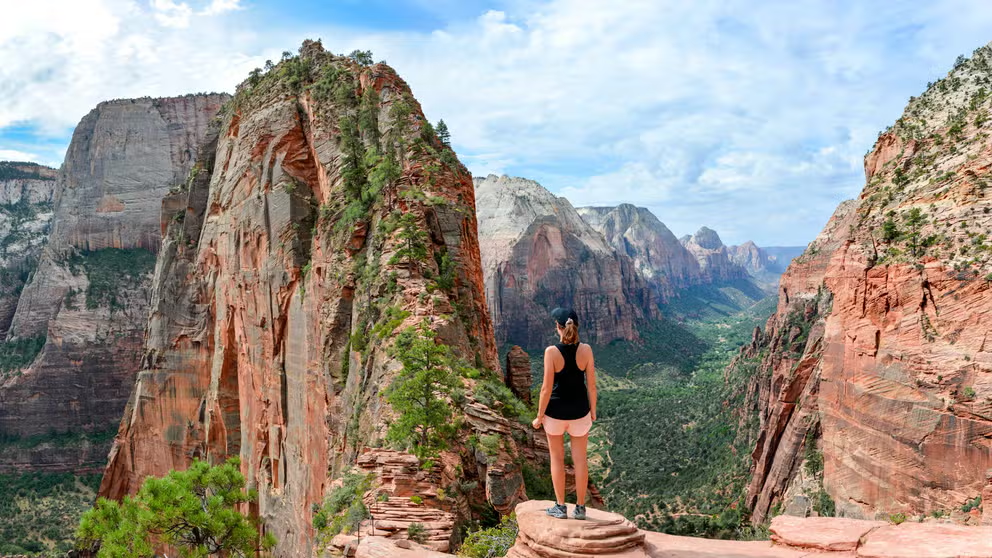Oasis amid the desert: Zion National Park is a treasure of the West
Iits 232 square miles give way to high plateaus, a maze of narrow, deep sandstone canyons and the Virgin River and its tributaries.
Zion National Park
Zion National Park boasts high plateaus, mazes of sandstone canyons, and the winding Virgin River.
Situated in southwest Utah near the Arizona and Nevada border lies the massive sandstone cliffs of Zion National Park.
Utah's first national park encompasses some of the most scenic canyons in the country.
The National Park Service says that its 232 square miles give way to high plateaus, a maze of narrow, deep sandstone canyons and the Virgin River and its tributaries.
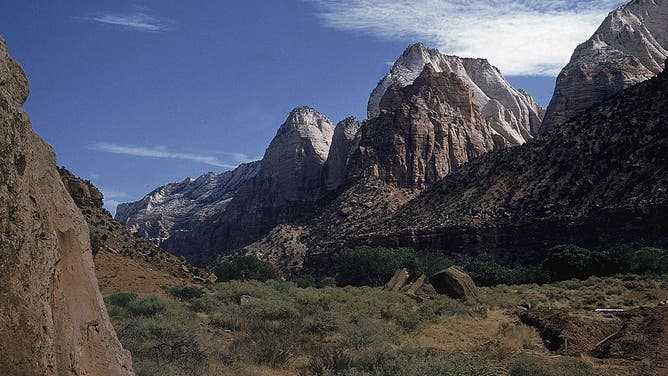
View of Mountain of the Sun (left) and East Temple in Zion National Park, Utah, c. 1975.
((Photo by Emil Muench/Getty Images) / Getty Images)
More than 5 million people visited the park in 2021, an increase of about 90% since 2010. The NPS says that visitation to Zion National Park has been increasing for decades, and the park is among a small group of national park areas to ever exceed 5 million annual visits.
Zion's diverse topography leads to many habitats and wildlife, including 1,000 species of plants and hundreds of different species of animals.
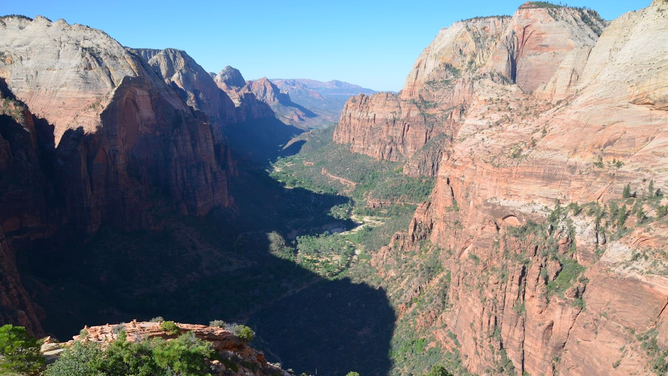
Hiking Zion National Park
(Photo: Steve Baron)
History
On November 19, 1919, President Woodrow Wilson signed a bill into law establishing the park. It originally started as Mukuntuweap National Monument in 1909 until given the national park status.
Zion, meaning "promised land," gives rise to its significance.
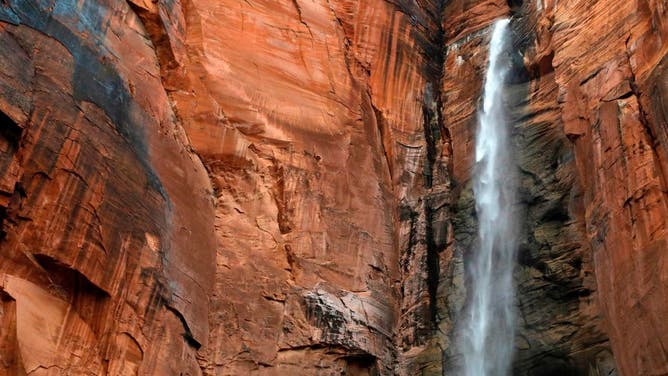
A waterfall runs through the rock in the Riverside Walk section of Zion Canyon in Zion National Park, Utah, on February 9, 2017.
(RHONA WISE/AFP via Getty Images) / Getty Images)
People have called the canyons and plateaus of Zion National Park home for over 10,000 years and stand as testaments to the ingenuity of those that came before us, according to the NPS.
The park's geology served pioneer farmers thanks to its vast, level ground and water from the river. On the Colorado Plateau, crops grow best between 5,000 and 7,000 feet, making Zion's elevations almost ideal, the NPS says.
The park also protects archeological sites. Not all are open to the public, but Zion says these fragile resources provide important clues to the past.
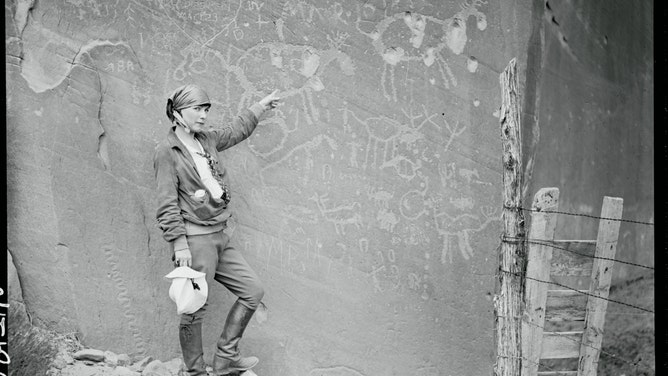
Pictographs found on a cliff between Zion National Park and the north rim of the Grand Canyon carved there by an artist of two or three thousand years ago.
(Getty Images)
In 2009, Congress protected nearly 84% of the park as wilderness under the 1964 Wilderness Act. NPS says that the designation protects the land’s wilderness character, natural conditions, opportunities for solitude, and scientific, educational, and historical values.
The power of water

Zion National Park
(Photo: Steve Baron)
The Virgin River and its tributaries run through the park, and the water serves as a life source for everything in Zion.
Water and the lack thereof decide what grows and what makes the variation in colors of the rocks.
Stratigraphy, which is the study of rock layers, gives an insight into how these rocks formed in various environments. Different sandstones show contrasting colors and record the movements of the sand dunes. The Kayenta mudstone features dinosaur tracks.
Summer months often bring monsoonal rainstorms.
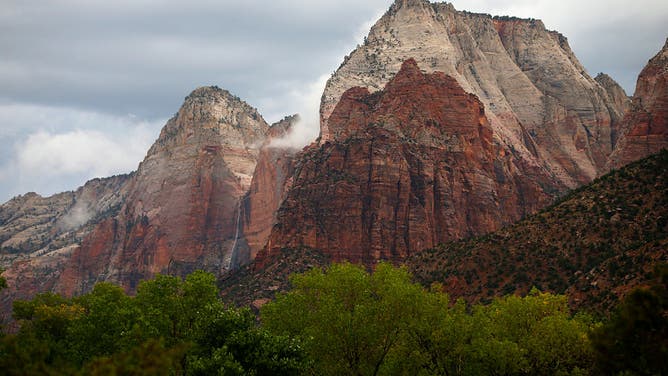
Water flows down rock faces after a rain storm in Zion's National Park on September 15, 2015 in Springdale, Utah. Four hikers died and three are missing after a flash flood yesterday that also killed several woman and children in two vans that were swept away by the flood waters.
((Photo by George Frey/Getty Images) / Getty Images)
It's estimated that the river removes 1 million tons of sediments, mainly during flash floods. The U.S. Department of the Interior says that the result of this is that the canyon continues to widen, and the river channel continues to deepen.
Recreation
The park encompasses 5,000 feet of elevation change, providing a variety of activities to visitors.
The popular summer vacation spot for families and adventurers offers hiking, camping, backpacking, climbing, etc.
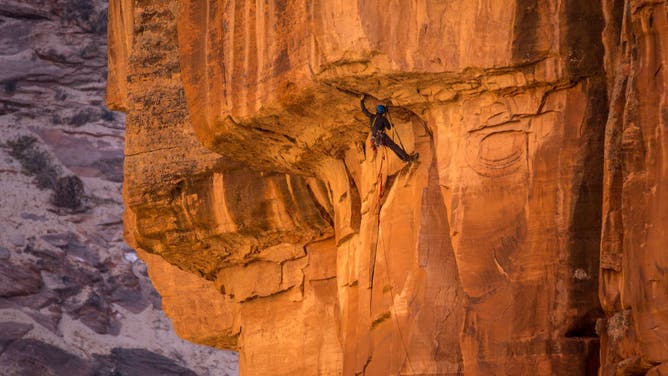
A rock climber attempts to scale a sandstone overhang on November 4, 2019 in Zion National Park, Utah.
((Photo by George Rose/Getty Images) / Getty Images)
The park is a climber's paradise. Its 2,000-foot sandstone cliffs are world-renowned for their big wall climbs.
Climbers head to the park from March through May and September through early November for the best conditions.
The park also offers easy to strenuous hikes.
One of the most well-known hikes offers spectacular views but is one of the world's most dangerous.
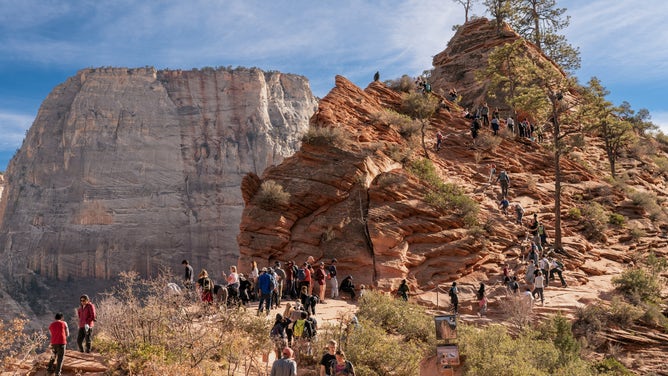
Hikers waiting to climb, climbing, or descending the trail to Angels Landing near Scout Lookout in Zion National Park.
(NPS / Lizz Eberhardt)
Angels Landing is a 2.2-mile hike but includes switchbacks over various terrain, exposed edges and long drop-offs. It stands almost 1,500 feet above the base of the Virgin River. The Department of the Interior says it's known as one of the most dangerous hikes globally.
And if you're looking for a bit of everything, the park has a Subway – but it's not a form of public transit. The Subway can only be entered by canyoneering and/or hiking. Requiring a permit, the trek requires route finding, rappelling and even swimming.

Zion National Park
(Photo: Steve Baron)
